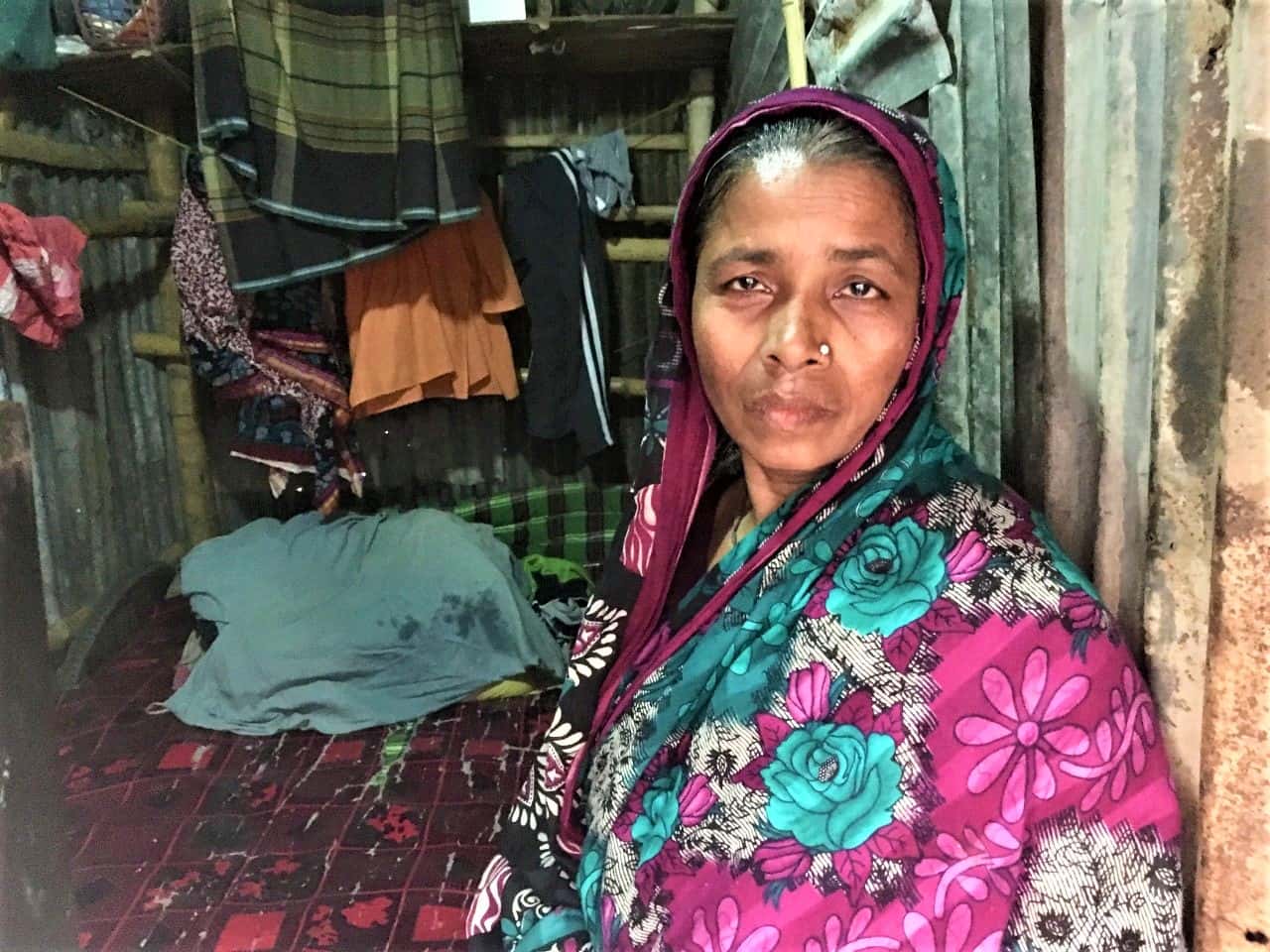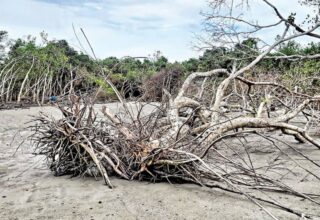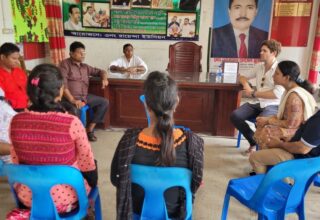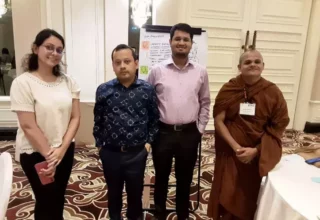
The slum is about the size of a basketball court.
Hidden behind a wall of corrugated iron, it is easily mistaken for a vacant lot or construction site, consisting of a series of sweatboxes, also made of corrugated iron, no larger than a couple of square metres each. They line two paths about 25 metres long, which are connected to one another at the back, near the washroom. A single commode services about 200 people.
For the residents, this small slice of Dhaka is home. They are all climate migrants.
“We moved here a year ago,” Bulia tells me. “The floods had been getting worse for years, but last year our land was completely destroyed. We lost everything.” Originally from Bagerhat District in Bangladesh’s south-west, the 35-year-old moved to the capital with her husband and two children after their rice and potato crops were wiped out. They arrived with nothing.
Josna, 51, came to Dhaka five years ago after her home on the banks of the Brahmaputra River in Manikganj District was similarly destroyed by flooding.
“At the time, I thought we were unlucky,” she says. “But now lots of people are arriving from Manikganj and saying the same thing happened to them.”
Josna is something of a leader here, a matriarch in regal purple, dominating the conversation.
“We have no clean water and have to boil everything,” she says. “In the monsoon season the entire area floods. The toilet backs up and the children get sick.” Like all the women here, Bulia and Josna work as domestic servants, making 150 Bangladeshi taka, or $A2.30, a day, while their husbands and elder sons ride cycle-rickshaws. The children start working – begging, mostly – as soon as they’re deemed old enough. The slum-dwellers receive no government assistance.
“We make enough to eat and that’s all,” Josna says. “It’s a hard life, but there’s nothing for us to go back to.”
In March, a World Bank report, “Groundswell: Preparing for Internal Climate Migration”, said that more than 140 million people in sub-Saharan Africa, South Asia and Latin America may be forced to move within their countries’ borders by 2050 as a result of climate change. Fifteen million are likely to be displaced within Bangladesh alone. The UN Intergovernmental Panel on Climate Change has previously predicted that rising sea levels will wipe out more cultivated land here – potentially 20 per cent of the country’s landmass – than anywhere else in the world.
When it comes to climate change and its effects – debates about its existence ended long ago in these parts – Bangladesh is one of a growing handful of countries where the future is already well under way. Dhaka may even be said to be the city of tomorrow.
It is a grim vision. Dhaka has unrivalled population density, inadequate infrastructure and rock-bottom living standards – last year it was ranked 214th among 231 cities for quality of living. According to Professor Narun Nabi, director of the Department of Population Sciences at the University of Dhaka, conditions here will only worsen as migrants arrive in ever-greater numbers.
“We can’t even look after the 18 million people who currently live in the Greater Dhaka Area,” he says. “We’re talking about seeing that number double by 2050. ” Based on population growth models, the Global Cities Institute at the University of Toronto projects that Dhaka will be the world’s third-largest city by mid century, with a population of some 35.2 million. “This will be an unmitigated disaster,” Nabi says.
“We have sanitation problems, sewerage problems, high levels of air pollution, unequal access to clean water and healthcare,” he says. “Forty per cent of the population lives in slums. Eighty per cent lives in conditions that are not much better. Population growth exacerbates these problems at a rate that outpaces our ability to address them.”
Nabi says one of the key problems is that Dhaka remains the literal and economic centre of the country: little has been done to develop mid-sized cities in other regions in a way that would make them attractive, not only to internal migrants, but to investors and the middle-class. “When everything is centralised in Dhaka – government decision-making, big business, opportunities – it’s not really surprising that everyone winds up here,” he says. “Decentralisation won’t solve the city’s problems, but it will give it enough breathing room to start catching up. It will release some of the pressure.”
The alternative, he says, is anarchy. “We won’t need to be invaded from outside. If the city’s population continues to grow at this rate and we do nothing to slow it, civil unrest will inevitably follow. I say this in all seriousness. We will be killing one another in the streets.”
A world away from this dystopian vision, in the ballroom of the Radisson Blu on the city’s airport road, Bangladesh is celebrating its eligibility to graduate from least-developed-country status to that of a developing one. It will officially do so in 2024 and has plans to graduate to developed status by 2041, a herculean undertaking requiring an eightfold increase in per capita income from current levels.
The director of the International Centre for Climate Change and Development, Dr Saleemul Huq, has faith in the country’s ability to face its current and future challenges. “Bangladesh may be ground zero as far as climate change is concerned, but as a result we’re also at the forefront of working out how to deal with it,” he says.
While not a great believer in infrastructural solutions – “All we can do is tinker at the edges, moving the traffic jam from one section of the city to another” – Huq does believe in the capacity of people to adapt to changing circumstances. He points to the country’s achievements in health as an example. “Whenever we used to have floods in this country, they would be followed by large outbreaks of cholera and other diarrhoeal diseases. You don’t see that anymore. You see photographs of women wading chest-deep in water on their way to collect clean drinking water. By educating the population through television and radio, by focusing on that human element, Bangladesh has all but defeated diarrhoeal disease.”
But there’s no doubt that climate change is unique. “On the one hand, it’s a long-term problem. On the other, we’re already seeing its effects. Increased coastal flooding, salinity intrusion, and the beginnings of what will become large-scale climate migration. As a result, we have to devise solutions on two separate but parallel time lines: a short-term one and a longer-term one of about a decade to two decades.”
The short-term solutions are aimed at slowing or arresting climate migration by assisting those in affected areas. For example, Huq says, varieties of saline-resistant rice are being developed, and in areas where saline levels are already too high farmers are being taught to breed prawns. But he also acknowledges that mitigation has its limits. “In the long run, we will lose these battles,” he says. “We know that people will no longer be able to live in these areas. But we can help them to stay there as long as possible and educate their children so they don’t have to be farmers when the time comes to leave.”
The question of where they will go when that happens leads us to the long-term solutions. Like Nabi, Huq believes developing mid-sized cities is the only real way that internal climate migration can be properly addressed.
“We are in the process of identifying, and have identified, a dozen inland towns that can become what we call climate-resilient, migrant-friendly cities,” he says. “They’re away from low-lying coastal areas and all have populations of about 500,000, which we’re looking to increase to about 1.5 million.
“If we can attract a million people to each of these towns – which means generating employment, developing ties with sister towns on the coast, exploiting ethnic connections – then that’s 12 million people who aren’t moving to Dhaka.
“Basically, we need to move away from what we have now, which is unplanned, distressed migration, to a model of planned, facilitated, positive migration.”
To date only three of the 12 towns under consideration have committed to the plan. “It’s true that the other nine are sceptical,” Huq says. “There’s a mindset against migrants as bad people, which we need to change.” This month, he will run a week-long workshop designed in part to convince the hold-outs. He’s confident he will be able to do so.
His optimism isn’t shared by some in the local human rights community. Mahbul Haque, the director of the Bangladesh Centre for Human Rights and Development, finds the government’s development goals ludicrous. “You get a different view of things at the granular level,” he says.
In the slum, when I ask Josna about the climate migrants expected to follow her and her neighbours to Dhaka over the next decade or so, she cocks an eyebrow and pats my knee.
“Do you really think we think about these things? We have other problems.”
Do they have any hope things can improve? Does Bulia believe that her children will have it better than her?
“My children have no future,” she says.
This article was first published in the print edition of The Saturday Paper on May 12, 2018 as “Climate of fear”. The author Matthew Clayfield is a freelance foreign correspondent of The Saturday Paper.






